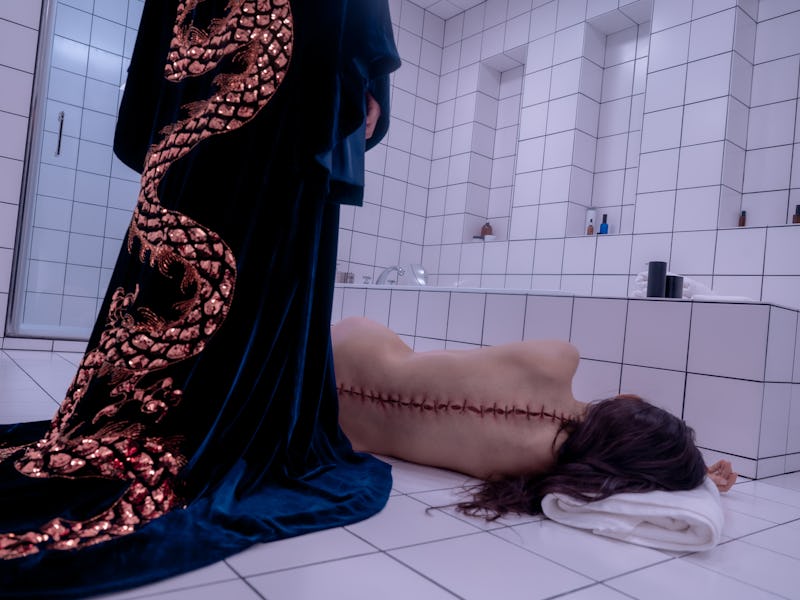The Substance is Style Over… Well, You Know
The body-horror satire takes the genre to truly wild places, but at a cost.

An aging Hollywood actress, once beloved by her peers and fans alike, gets ousted in favor of a younger, newer model. In her despair, she spirals out of control and rages against the industry that has used up her youth — to no avail. It’s a story we’ve all heard before and the subject of countless Hollywood classics, from Sunset Boulevard to All About Eve. But The Substance, the wild body-horror thriller from Revenge director Coralie Fargeat, attempts to put a grisly spin on an old classic with a tale of doppelgangers, mysterious injections, and repulsive monsters.
However, in its admirably gory attempts to push the envelope, The Substance never manages to say anything interesting.
Demi Moore gives a fearless, but over-the-top, performance as fading star Elisabeth Sparkle.
The Substance opens on a series of intriguing images: an egg yolk, injected with a mysterious substance, which instantly births a second egg yolk. Then, we cut to a bird’s eye view of a star on the Hollywood Walk of Fame, from its creation to its inevitable fate as a cracked, forgotten square of sidewalk, dirtied by dog poop and dropped hamburgers. That square belongs to Elisabeth Sparkle (Demi Moore), a fading star who was just fired from her only gig as the host of a peppy aerobics show. They’re looking for someone younger, hotter, more relevant, show producer Harvey (Dennis Quaid, in his most gratingly over-the-top performance) tells her. Humiliated, Elisabeth drives home in a daze, only to get into a brutal car accident from which she miraculously emerges unscathed — something her eerily beautiful nurse (Oscar Lesage) observes, handing her a card with just a phone number and the words “The Substance,” with the promise, “It changed my life.”
It’s only after Elisabeth spots an advertisement for auditions to be “the next Elisabeth Sparkle” that she calls the number and finds herself at a warehouse with a package containing “the Substance” and a series of instructions for her and her “Other Self” once the procedure is complete. Stripping down in her bathroom, she makes the necessary injections and immediately falls to the floor writhing, a second eyeball growing in her socket and her back splitting open. A bloody mass of organs and body parts then fall out and form into a second body — her younger self, played by Margaret Qualley. But youth has its drawbacks: Elisabeth and her younger doppelganger, who dubs herself “Sue,” must switch back and forth every seven days, one lying comatose on the bathroom floor while the other gets to live life. As Sue’s star begins to rise, she starts to eat away at Elisabeth’s life… literally.
There’s nothing subtle about The Substance. The entire movie is telegraphed, from its opening series of images to its annoyingly obvious themes that hit you over the head, over and over. Did you know that society is merciless to women as they age? Did you know that youth is the only currency worth anything in Hollywood? Do you know that getting old is the same as turning into a monster?
Do you love Margaret Qualley’s ass? Then The Substance is for you.
Since its premiere at this year’s Cannes Film Festival, The Substance has been hailed as a nu-feminist classic, a grotesque riff on Oscar Wilde’s The Picture of Dorian Gray, which replaces Wilde’s commentary on hedonism with a metaphor for being an older woman in Hollywood. But for all its feminist diatribes, The Substance is still a movie that is 80 percent extreme close-ups of Margaret Qualley’s ass. In nearly every other scene, the camera lovingly pans over her spandex-clad exterior, in sequences that are shot like ‘90s Viagra commercials. Qualley is, to her credit, happy to play both objectified and the objectifier — doe-eyed and chipper as the sweet ingenue, sneering and sinister when she starts to take over Elisabeth’s life. And while Moore is impressively game to throw herself into the movie’s more bonkers swings, it’s when she goes full hagsploitation (in her “No wire hangers!” moment) that The Substance loses sight of itself.
Everything about The Substance is actively hostile — from the Shining-inspired hallways, to Elisabeth’s clinically white bathroom, to every single disgusting eating scene. (Fargeat seems to have an affinity for intense close-ups of open mouths chowing down on the wettest, slimiest, most unappetizing pieces of food.) It’s a movie that wants to put you on edge, that makes you squirm and cringe away, because isn’t society’s treatment of women just so awful? It literalizes every bloody pound of flesh that starlets like Elisabeth and Sue pay to stay in the spotlight, but once the shock wears off, The Substance has nothing to show behind its excessive style.
There’s no denying that Fargeat has ballsy directorial flair. The film’s garishly bright color palette complements the bizarre alternate reality where hosting an aerobics show is a one-way ticket to stardom, and where every building seems to have been built by Stanley Kubrick’s production designer. Its editing is sharp and cutting, its uncanny frames riffing on (but never quite capturing) De Palma. Fluids and oozing, bruised flesh become a gross de rigueur. And once those gaudy colors give way to obscene gore, it’s easy to get carried away with the film’s unhinged body-horror spectacle — especially the outrageously gory final act that puts Carrie’s buckets of blood to shame. The gruesome prosthetics, courtesy of makeup artist Pierre-Olivier Persin, are a particular standout for the film, and almost makes up for its wafer-thin story.
But The Substance spins its wheels for too long, treating us to montage after montage of Qualley’s ass and Moore’s freakish transformations. By the time its wildly audacious finale rolls around, and the blood and gore starts spraying, the film’s whole premise has started to feel tiresome. The Substance it turns out, needed a little more, well, substance.